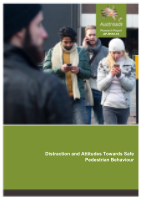Road Safety

- Publication no: AP-R510-16
- ISBN: 978-1-925451-00-9
- Published: 26 February 2016
- PDF (free) Download
Pedestrians account for around 14% of Australian road deaths annually. International research suggests that pedestrian distraction from smart phones may lead to greater risk of trauma. Ownership of smart phones in Australia is high, suggesting this may present an emerging road safety challenge.
Austroads commissioned research to identify: community attitudes towards, and personal, social and environmental factors influencing, safe pedestrian behaviour; groups most at risk of distracted walking; most likely locations; and effective countermeasures. The project had three components: a literature review; an intercept survey with pedestrians; and an on-line survey of pedestrians.
The literature review identified that pedestrian distraction from technology is influenced by age, gender, and type of activity. Non-intersection locations are more likely than intersections for pedestrian crashes generally, though there is no research on distraction-specific crashes. Illegal pedestrian behaviours may be both common and riskier. Many effective countermeasures address general pedestrian crash risk, but few address distraction from mobile phones while crossing, and these have been educational in nature, with unproven effectiveness.
Surveys results suggested that use of smart phone while crossing the road was low for the sample overall, but significantly higher among 18-30 year olds, with 30% indicating they used their smart phones for texting or internet access at risky levels while crossing the road. Risk perception and attitudes towards using a smart phone while crossing were important factors influencing likely behaviour for 18-30 year olds. Countermeasures should integrate education and engineering interventions within a Safe System approaches, target pedestrians under 30 years, and be located at high pedestrian activity locations.
- Summary and Recommendations
- Contents
- 1. Introduction
- 1.1. Background and aims
- 1.2. Structure of the report
- 2. Literature Review
- 2.1. Background and Scope
- 2.2. General factors that influence pedestrian behaviour and safe road use
- 2.3. Pedestrian distraction from use of hand-held technological devices
- 2.4. Locations where pedestrian crashes are most likely
- 2.5. Influence of the built environment on likelihood of pedestrian crashes
- 2.6. Walking after having consumed alcohol (“drink walking”)
- 2.7. Countermeasures to distracted or risky pedestrian behaviour
- 3. Investigating Pedestrian Use of Potentially Distracting Technology While Walking and Crossing the Road
- 3.1. Intercept interviews
- 3.2. Online Survey
- 4. Conclusions and Recommendations
- 4.1. Recommended measures to address road safety issues
- 4.2. Recommended areas for future research
- References
- Appendix A Review of Research Relating to Factors Influencing Pedestrian Behaviour and Safe Road Use
- Appendix B Intercept Interview Schedule
- Appendix C Summary of Results for Intercept Interview Responses to Drink Walking Questions
